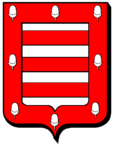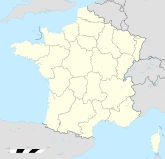- Many
-
Many 
Region Lothringen Département Moselle Arrondissement Boulay-Moselle Kanton Faulquemont Koordinaten 49° 0′ N, 6° 31′ O49.00256.5216666666667250Koordinaten: 49° 0′ N, 6° 31′ O Höhe 250 m (242–328 m) Fläche 8,22 km² Einwohner 254 (1. Jan. 2008) Bevölkerungsdichte 31 Einw./km² Postleitzahl 57380 INSEE-Code 57442 Many (deutsch Niederum) ist eine französische Gemeinde mit 254 Einwohnern (Stand 1. Januar 2008) im Département Moselle in Lothringen.
Geografie
Die Gemeinde Many liegt etwa 30 Kilometer südöstlich von Metz und sieben Kilometer südwestlich von Faulquemont.
Geschichte
Das Dorf lag im Mittelalter noch im deutschen Sprachgebiet und wurde 1180 erstmals als Niderheim erwähnt, ist aber mittlerweile seit Jahrhunderten frankophon. Nördlich führt eine alte Römerstraße vorbei, südlich liegen die Überreste des um 1580 aufgegebenen Dorfes Marcourt.
Many gehört seit 1766 zu Frankreich. 1871–1918 gehörte es vorübergehend noch einmal zum Deutschen Reich, Französisch blieb aber Amts- und Umgangssprache.
Bevölkerungsentwicklung
Jahr 1962 1968 1975 1982 1990 1999 2007 Einwohner 175 171 172 170 196 237 250 Adaincourt | Adelange | Arraincourt | Arriance | Bambiderstroff | Créhange | Elvange | Faulquemont | Flétrange | Fouligny | Guinglange | Hallering | Han-sur-Nied | Hémilly | Herny | Holacourt | Laudrefang | Longeville-lès-Saint-Avold | Mainvillers | Many | Marange-Zondrange | Pontpierre | Teting-sur-Nied | Thicourt | Thonville | Tritteling-Redlach | Vahl-lès-Faulquemont | Vatimont | Haute-Vigneulles | Vittoncourt | Voimhaut
Wikimedia Foundation.
Schlagen Sie auch in anderen Wörterbüchern nach:
Many — Ma ny, a. & pron. Note: [It has no variation to express degrees of comparison; more and most, which are used for the comparative and superlative degrees, are from a different root.] [OE. mani, moni, AS. manig, m[ae]nig, monig; akin to D. menig,… … The Collaborative International Dictionary of English
Many a — Many Ma ny, a. & pron. Note: [It has no variation to express degrees of comparison; more and most, which are used for the comparative and superlative degrees, are from a different root.] [OE. mani, moni, AS. manig, m[ae]nig, monig; akin to D.… … The Collaborative International Dictionary of English
many — [men′ē] adj. more, most [ME < OE manig, akin to Ger manch (OHG manag) < IE base * menegh , many, richly > Sans maghā , gift, OIr menicc, abundant] 1. consisting of some large, indefinite number (of persons or things); numerous 2.… … English World dictionary
many a/an — formal + literary used with a singular noun to refer to a large number of things or people It remained a mystery for many a year. [=for many years] I ve been there many a time. [=many times] Many a tale was told. [=many tales were told] Man … Useful english dictionary
Many — Ma ny, n. [AS. menigeo, menigo, menio, multitude; akin to G. menge, OHG. manag[=i], menig[=i], Goth. managei. See {Many}, a.] 1. The populace; the common people; the majority of people, or of a community. [1913 Webster] After him the rascal many… … The Collaborative International Dictionary of English
many — many, several, sundry, various, divers, numerous, multifarious mean consisting of a large number or comprising a large group. Many implies a likeness between the individuals or units in class, category, kind, or sort; except that it vaguely… … New Dictionary of Synonyms
Many — may refer to: plural A quantifier that can be used with count nouns often preceded by as or too or so or that ; amounting to a large but indefinite number; many temptations ; a good many ; many directions ; more than a few, more than several… … Wikipedia
Mány — Administration … Wikipédia en Français
many — 1. Many, like much, tends to sound more formal in positive contexts (They have many friends) than in negative ones (They do not have many friends). In conversation and less formal written English, a lot of (or, even more informally, lots of) is… … Modern English usage
Mány — Mány … Wikipedia

